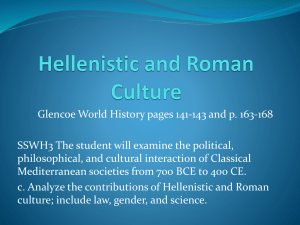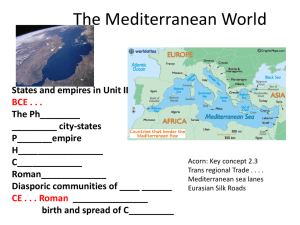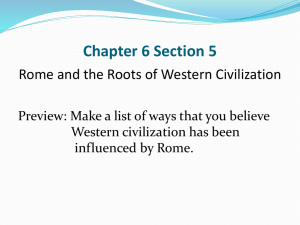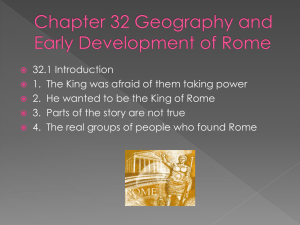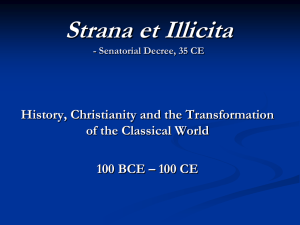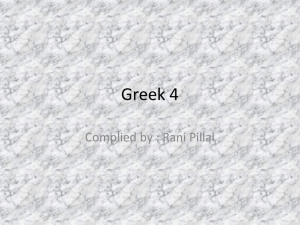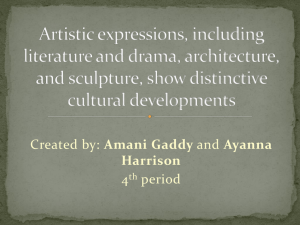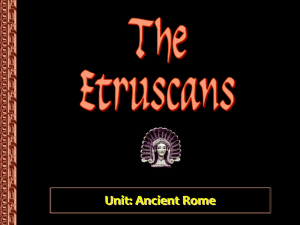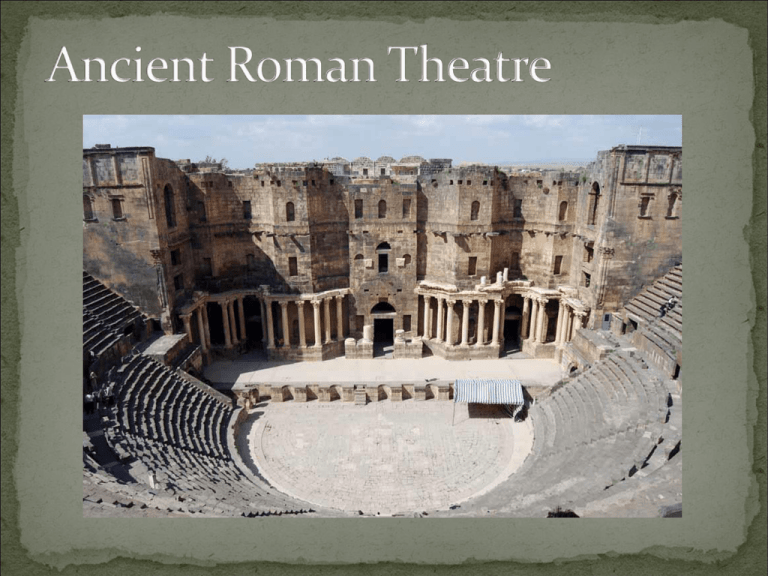
When Italy emerged into the light of history about 700 BCE,
it was already inhabited by various peoples of different
cultures and languages. Most natives of the country lived in
villages or small towns and supported themselves by
agriculture or animal husbandry (Italia means “Calf Land”).
By 700 BCE several Greek colonies were established along
the southern coast. Both Greeks and Phoenicians were
actively engaged in trade with the Italian natives.
The Etruscans were the first highly civilized people of Italy.
Encyclopedia Britannica online
Etruria & the Etrucans
The region and its people/tribe
to the immediate north of
Rome
Their civilization is established
7th century BCE
Peak of power/influence
6th century BCE
Earliest kings of Rome
were Etruscans
Rome achieves dominance
in the 3rd century BCE
Many features of Etruscan
culture adopted by Rome
Since the Etruscans were the dominant civilization on
the Italian peninsula immediately before the Romans
surpassed them, many features of Etruscan culture
were adopted by the Romans.
For example:
Rome inherited many features of Etruscan religious
festivals…and, religious festivals were the only
occasions during which theatrical performances were
given.
An Etruscan ruler established the ludi Romani, the
festival at which Greek drama was eventually first
presented.
Began as a small town and quickly grew into a vast empire
Unlike the Greeks, who excelled in intellectual and artistic endeavors,
the Romans achieved greatness in their military, political, and social
institutions.
Encyclopedia Britannica online
From its beginning, Rome incorporated
conquered peoples into its social and political
system.
Allies and subjects who adopted Roman ways
were eventually granted Roman citizenship.
Unparalleled professional military
Fantastic engineers
Excelled at bureaucratic, civil administration
Romans are noted for adopting the ideas and practices of
others, such as…
Etruscans (as stated previously)
Phoenicians
Greeks
Romans embraced Greek artistic forms and borrowed a
great deal from their art and literature
By 300 BCE, Greek tutors were in demand in Rome
By 146 BCE Rome had conquered Greece
As we will see, most Roman plays were translations or
adaptations of Greek originals
The earliest native Italian farce
perhaps descended from Greek phlyakes
Name derived from the town of
Atella in the Campania region of
southern Italy
not originally Latin/Roman
different native tribe
Featured masked stock characters
Maccus - the clown
Bucco (“Fat Cheeks”) - the simpleton
Pappus - the old fool
Dossennus - the hunchback
Manducus – the glutton
rustic/rural settings, characters, and language
base subject matter (cheating, gluttony, fighting, sex)
crude jokes and buffoonish physical antics
improvisational comedy
featured masked stock characters
presented at ludi since 3rd century BCE, but never written
down until c. 100BCE–75BCE
reached height of popularity in 1st century BCE
major influence on Renaissance commedia dell’arte
Represent broadly drawn stereotypes
More of a caricature because of the exaggerated manner
in which characteristics are portrayed
Establish instant audience expectations based on:
memories of previous performances
assumptions and biases
easily recognizable traits (physical, verbal, behavioral)
Earliest stock types are found in Greek Old Comedy:
the alazon – the boastful imposter
the eiron – used self deprecating irony to deflate the alazon
the bomolochus – the clown/buffoon
The Regal Period 753BCE – 509BCE
Mainly ruled by Etruscan monarchs
Atellan Farce
The Republic 509BCE – 27BCE
Regular drama thrives
ludi Romani
The Empire 27BCE – 476CE
Regular drama largely abandoned in favor of spectacle and
variety entertainment
ludi publici (“public games”) were ancient Roman
spectacles, primarily consisting of chariot races and
various kinds of theatrical performances, usually held
at regular intervals in honor of some god (they are
distinct from the gladiatorial contests which were
associated with funeral rites).
Most state-sponsored theatrical performances were
given at official these religious festivals, or ludi.
(This should sound familiar, no?)
The oldest and most famous festival was the ludi Romani
began in the 6th century BCE
held in September
honored Jupiter
364 BCE – began to include theatrical performances
240 BCE – regular comedy and tragedy presented
Directly comparable to the Athenian’s City Dionysia
Theatre during the Empire became increasingly diversionary, not
so much about “art.”
Romans craved variety, novelty, and lavish spectacle (and much
gratuitous violence) in their entertainment:
Gladiatorial contests
Chariot races
Horse races
Sea battle reenactments in a flooded Coliseum
Trained animal acts (or untrained for unlucky prisoners)
Animal fights
Acrobats, jugglers, and other circus-like performances
Wrestling & boxing matches
Regular drama had much to compete with for the public’s attention
The earliest notable Roman playwrights were…
Livius Andronicus (fl. 240 BCE – 204 BCE)
first to adapt & translate Greek plays into Latin
his were the first important literary works in Latin
not originally from Rome
considered to be better at tragedy
Gnaeus Naevius (fl. 235 BCE – 201 BCE)
first native-born Roman dramatist
“naturalized” drama by introducing Roman allusions into Greek
originals, and…
also wrote some plays based on Roman stories rather than Greek
considered to be better at comedy
Apparently they did…but unfortunately none survive
Plays based on Greek originals were called
fabula palliata
Plays based on Roman material were called
fabula togata
The Latin word fabula means:
“story, play, fable, narrative, account, tale”
literally “that which is told”
palliata derives from pallium, the Latin name for the
himation (a Greek cloak), so fabula palliata means roughly
“a play in Greek dress.”
Likewise, togata derives from the Roman toga, therefore it
means “a play in Roman dress.”
All of his surviving plays are based on Greek
New Comedy originals
He added many Roman allusions, such as…
place names, towns, landmarks, etc.
Latin names for characters
Roman manners and customs
His works featured…
boisterous, often coarse humor
physical comedy
fast-paced action
burlesque
much from Atellan farce
Wrote six plays (comedies), all have survived
Wrote more complex plots
Combined stories from
multiple Greek originals
Avoided inserting Roman
allusions
Never matched the popularity
of Plautus
Their works are valued as models of spoken Latin
Later critics considered their works to be the foremost
examples of comic drama, therefore…
Their works exerted enormous influence a millennium
and a half later during the Renaissance
They eliminated the chorus of the Greek plays
Musical accompaniment was added to the dialogue
Their works are the only extant examples of Roman
comedy…and ALL are based on Greek originals
No Roman tragedies survive
Based on fragments, titles, and the commentary of
contemporary critics, most were…all together now…
BASED ON GREEK ORIGINALS
It seems that no tragedies intended for public performance
were written after 29 BCE
The only extant Roman tragedies are closet dramas from
this later period
“closet drama” refers to works written primarily for reading
rather than production
closet in this context does not refer to our modern
understanding of a place to hang clothes; it means “private”
or “secret.”
Author of all but one of the extant Roman tragedies
All were adapted from Greek originals
Born in Spain, educated in Rome
Was tutor to the eventual
Emperor Nero
Also renowned as a philosopher
His works were not written for
performance, but were perhaps
recited at elite gatherings
His works became the model for
much of Renaissance tragedy
(“revenge tragedy” in particular)
Characteristics:
Divided into five episodes
Long, elaborate speeches
reflective soliloquies
declamatory, narrative accounts of action
bombastic rhetoric
Moralizing
Violence and horror
Supernatural elements (ghosts, witches, magic)
Characters dominated by a single obsessive passion (e.g., revenge)
Theatrical devices such as soliloquies (see above), asides, and
confidantes; all allow characters to reveal inner thoughts
Later, we will see how highly influential this model was to become
during the Renaissance
Atellan Farce (fabula Atellana)
Pantomime (pantomimus)
literally "imitator of all"
Mime (mimus)
from Greek mimos "imitator, mimic, actor, mime, buffoon"
a story telling dance, as such it was…
a forerunner of today’s ballet
a solo performance
plots taken from mythology or history
accompanied by a chorus singing explanatory narration
also an orchestra of flutes, pipes, and cymbals
mostly serious, though occasionally comic
usurped tragedy’s position of favor with sophisticated
audiences
Originally a short but elaborate dramatic form:
utilized large casts and spectacle (impressively lavish visual
display)
usually a satiric/comic treatment of some common, everyday
aspect of life – similar in this way to Greek New Comedy
Especially disliked by the Christians whose sacraments and
beliefs were often ridiculed on stage
Over time, to cater to evolving public tastes, mime troupes
presented a wide range of incidental entertainment, e.g.,
trapeze and tightrope acts, juggling, stilt walking, fire spitting,
sword swallowing, trained animals, singing, dancing, etc.
Therefore, eventually the term was applied to almost any kind
of theatrical entertainment
At the end of the Roman era, mime actors were performing
throughout the empire, but after the triumph of Christianity
the theatre of the day was abominated by the Church Fathers
as an art so debased as to have lost any relevance to the general
good of society. In the 5th century all performers of mime were
excommunicated, and in the following century the theatres
were closed. The mimes dispersed. Though the church did its
best to prohibit them through the Middle Ages, they managed
to carry on their art illicitly, finding audiences wherever they
could. Mime, as performed by jesters, jongleurs, bands, and
acrobats, is an unbroken dramatic tradition that reaches from
the Classical world to modern Europe.
-Encyclopedia Britannica online

